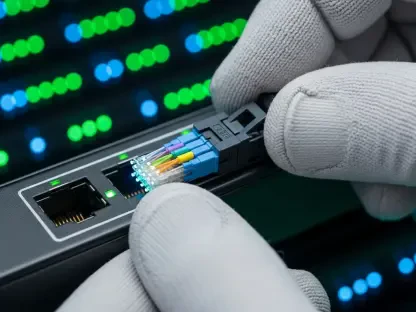In Malaysia, the race to build a robust digital economy is accelerating, with 5G technology at the forefront of this transformation, and a staggering RM4.3 billion financing deal secured by U Mobile, one of the country’s leading telecommunications providers, has sparked widespread discussion among industry stakeholders. This funding, aimed at achieving 80% coverage of populated areas by mid-2026, signals a monumental shift in connectivity potential. This roundup dives into diverse opinions, expert analyses, and strategic insights from various corners of the telecom and financial sectors to unpack what this ambitious 5G rollout means for Malaysia’s future, exploring both the opportunities and challenges that lie ahead.
Diving into the Financial Backbone of 5G Expansion
Unpacking the Scale of the RM4.3 Billion Deal
The sheer magnitude of U Mobile’s RM4.3 billion syndicated financing has caught the attention of financial analysts across the region. Many industry observers note that this deal, supported by major banks such as CIMB and Maybank, stands as one of the largest Ringgit-denominated transactions in Malaysia’s history. This level of investment reflects a strong belief in the telecom company’s ability to execute its vision, with several banking sector commentators highlighting the rigorous due diligence that likely preceded such commitments.
Beyond the numbers, there’s a consensus that this funding is a game-changer for capital expenditure in 5G infrastructure. Analysts from the financial sector emphasize that the resources will enable rapid deployment of network towers and advanced technologies. However, some caution that the scale of this investment also introduces risks, particularly if deployment timelines face delays due to logistical or regulatory hurdles.
A contrasting view comes from smaller financial institutions, which point out that while lender confidence is high, the pressure on U Mobile to deliver measurable results by 2026 is immense. They argue that balancing speed with quality will be critical to maintaining trust from both investors and consumers. This diversity in perspective underscores the high stakes tied to this historic financing.
Economic Implications for Malaysia’s Digital Ambitions
Economic experts have weighed in on how this investment could ripple through Malaysia’s broader economy. Many suggest that enhanced 5G connectivity will likely attract foreign investment in tech-driven industries, positioning Malaysia as a regional hub for innovation. This optimism is fueled by the potential for improved infrastructure to support sectors like manufacturing and logistics with real-time data capabilities.
On the flip side, some economists express concern over the digital divide, noting that urban areas might benefit disproportionately compared to rural regions. They advocate for a balanced rollout strategy to ensure that economic growth is inclusive, preventing a scenario where only certain demographics reap the rewards of advanced connectivity. This viewpoint stresses the need for policy support alongside private sector efforts.
Another angle comes from trade analysts who see this as a catalyst for small and medium enterprises. They believe that access to faster, more reliable networks could empower local businesses to compete on a global scale, provided that the affordability of 5G services remains a priority. These varied economic insights paint a complex picture of both promise and precaution surrounding the rollout.
Strategic Perspectives on U Mobile’s 5G Deployment
Prioritizing High-Impact Areas for Connectivity
U Mobile’s strategy to focus initial 5G deployment on high-traffic zones like airports, hospitals, and convention centers has garnered mixed reactions from telecom strategists. Many praise this targeted approach, arguing that prioritizing critical hubs ensures immediate impact where connectivity demands are highest. They point to the ULTRA5G network launch in August as a promising start to transforming user experiences in such locations.
However, some industry planners question whether this focus might delay broader coverage in less populated areas. They suggest that while urban centers are vital, a phased plan incorporating suburban and rural zones sooner could prevent long-term disparities in access. This critique highlights a tension between short-term wins and long-term equity in network expansion.
A third perspective from enterprise consultants focuses on the benefits to businesses operating in these high-impact zones. They argue that seamless 5G access in key venues will drive adoption of advanced applications, from smart healthcare solutions to real-time event management. This viewpoint sees U Mobile’s strategy as a stepping stone to positioning Malaysia as a leader in enterprise-grade connectivity.
Embracing 5G-Advanced Technology Early
The decision by U Mobile to integrate 5G-Advanced capabilities from the outset has been a hot topic among technology experts. A significant number of tech analysts commend this forward-thinking move, noting that it positions the telecom company ahead of global trends. They believe that leveraging cutting-edge features will enhance network reliability and speed, setting a high standard for competitors.
Contrarily, some tech commentators warn that adopting advanced technology early could lead to compatibility issues or higher maintenance costs. They suggest a more cautious rollout of such features, allowing time for market readiness and consumer adaptation. This concern reflects a broader debate on the pace of innovation versus stability in telecom infrastructure.
Meanwhile, regional tech observers highlight how this aligns with Malaysia’s unique position in Southeast Asia, where digital inclusion remains a priority. They argue that 5G-Advanced could bridge gaps in access if paired with initiatives to educate and equip underserved communities. This angle emphasizes the transformative potential beyond mere consumer applications, focusing on societal benefits.
Adapting to a Dual 5G Network Policy Shift
The Malaysian government’s pivot from a single 5G network under Digital Nasional Berhad (DNB) to a dual-network model, with U Mobile’s approval by the MCMC in November 2024, has sparked lively discussion among policy analysts. Many view this shift as a progressive step toward fostering competition, which could drive down costs and improve service quality for end users. They see the regulatory change as a nod to market dynamics.
On the other hand, some regulatory experts express reservations about the complexities of managing two networks. They point out potential challenges in spectrum allocation and infrastructure sharing, which could lead to inefficiencies if not carefully coordinated. This perspective calls for robust oversight to ensure that competition doesn’t compromise overall network performance.
A different take from global telecom consultants compares Malaysia’s approach to other countries with dual or multiple 5G networks. They suggest that lessons from these markets indicate a need for clear guidelines on collaboration between operators and government bodies. This international lens offers a broader context, urging stakeholders to anticipate and mitigate policy-related friction.
Industry Takeaways for Stakeholders and Consumers
Industry leaders have distilled several lessons from U Mobile’s ambitious plans that could guide other players in the telecom space. A common theme is the importance of securing substantial financing while maintaining transparency with investors about deployment challenges. Many agree that balancing rapid expansion with sustainable growth requires meticulous planning and risk assessment.
Another insight shared by sector veterans is the value of public-private partnerships in achieving national digital goals. They recommend that telecom companies collaborate closely with regulatory bodies to align rollout strategies with public needs, ensuring that infrastructure development serves a wider purpose. This advice underscores the role of synergy in scaling such large-scale projects.
For consumers and businesses, the consensus is to stay informed about 5G developments and explore early adoption in areas where services become available. Industry watchers suggest that enterprises, in particular, should assess how enhanced connectivity can streamline operations, while individual users might benefit from exploring new digital tools enabled by faster networks. These practical tips aim to prepare various groups for the impending connectivity boost.
Reflecting on a Milestone for Malaysia’s Telecom Landscape
Looking back, the discussions surrounding U Mobile’s RM4.3 billion financing and 5G rollout revealed a blend of optimism and caution among industry voices. The diverse opinions on financial risks, strategic priorities, and policy shifts painted a nuanced picture of a sector at a pivotal juncture. The consensus acknowledged the transformative potential of this investment in reshaping connectivity across Malaysia.
Moving forward, stakeholders were encouraged to monitor how the dual-network model evolves and to advocate for inclusive coverage that reaches beyond urban centers. A key next step involved fostering dialogue between telecom companies, regulators, and communities to address emerging challenges. Additionally, businesses and individuals were urged to explore pilot programs or partnerships that could leverage 5G capabilities early on, setting the stage for broader innovation in the years ahead.









